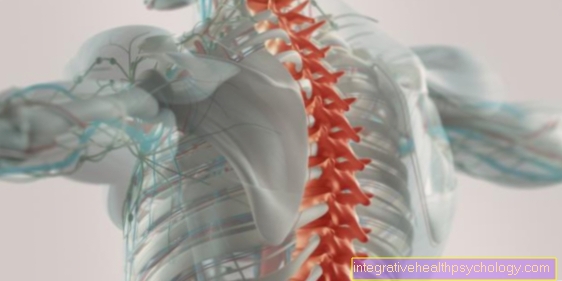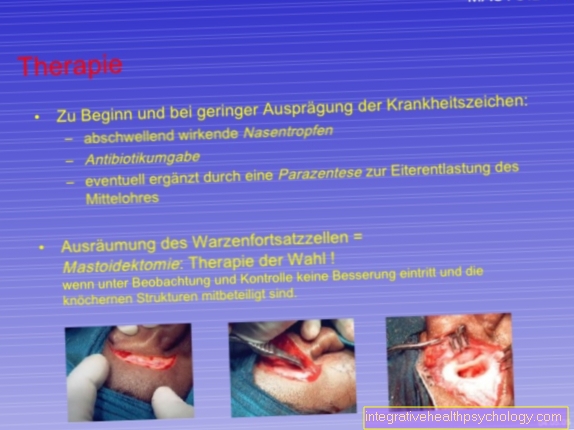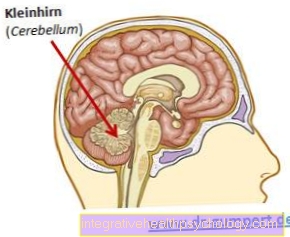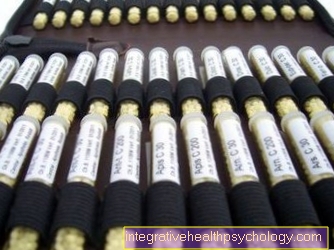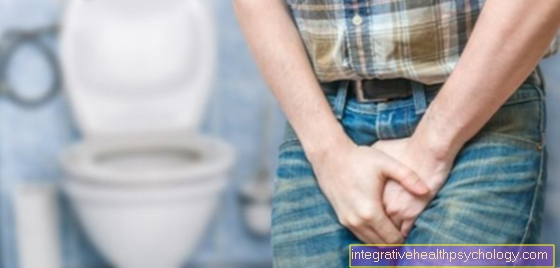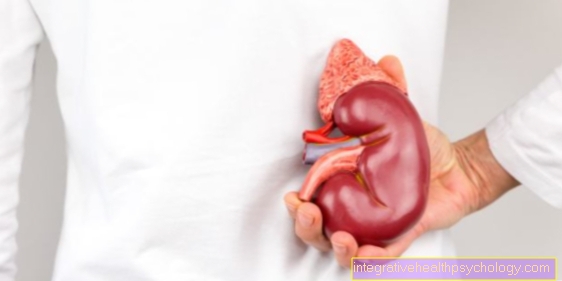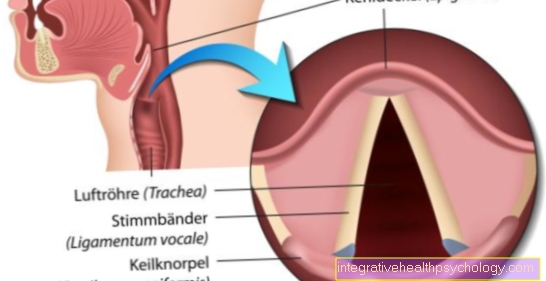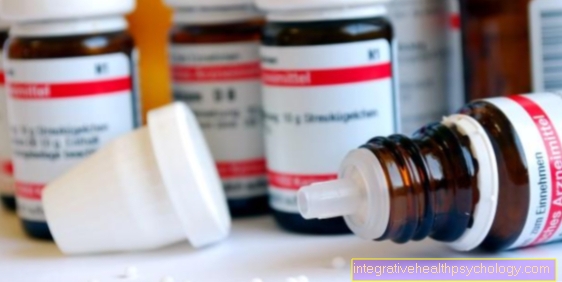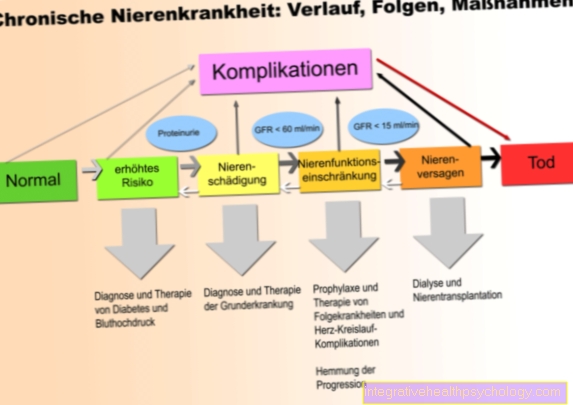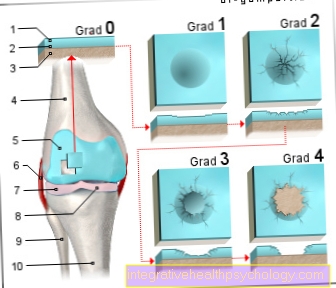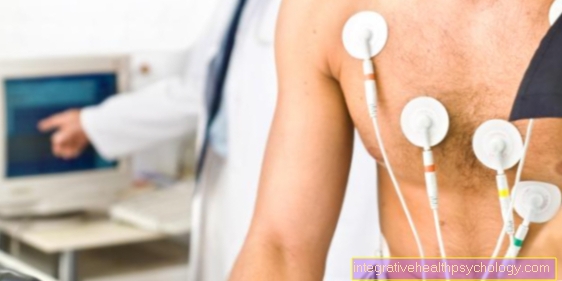Therapy of a herniated disc of the cervical spine
introduction
In the case of a herniated disc of the cervical spine (cervical spine), the tissue of the gelatinous core of an intervertebral disc emerges, usually due to a constant incorrect posture of the head (Nucleus pulposus) in the area of the cervical spine. The tissue mostly emerges backwards into the spinal canal, laterally to the nerve roots, or less often down to the next lower lying disc and its nerve roots.
The pressure on the respective nerve root can lead to various symptoms of a herniated disc of the cervical spine, such as restricted mobility, neck or headache as well as pulling electrifying pain at the point of the incident, which can radiate to the fingertips.

In addition, neurological symptoms such as paralysis or loss of strength in the arms, hands and fingers or sensory disturbances (e.g. pins and needles, tingling or numbness) can occur.
If the spinal cord is compressed as a result of the herniated disc of the cervical spine, this can even result in life-threatening respiratory impairment.
In the treatment of a herniated disc of the cervical spine, both conservative and operative concepts can be considered. A herniated disc of the cervical spine can usually be treated conservatively, i.e. without surgery, as the leaked tissue of the disc usually resorbs itself after a while. The aim of conservative therapy for a herniated disc of the cervical spine is to reduce pain and strengthen the neck and back muscles in order to prevent incorrect loading or overloading of the cervical spine. The conservative therapy of a herniated disc of the cervical spine therefore mainly includes the administration of various pain relievers and regular physiotherapy. If there is no response to conservative therapy or if additional neurological complaints (e.g. paralysis or sensory disturbances) occur, an operation of the herniated disc of the cervical spine should be performed.
Medical therapy
The conservative therapy of a herniated disc of the cervical spine includes the administration of various drugs. It is particularly important to give painkillers, which prevent pain in the case of a slipped disc in the cervical spine and at the same time have an anti-inflammatory effect.
Usually preparations from the group of non-steroidal anti-inflammatory drugs (NSAIDs), such as ibuprofen, diclofenac or naproxen. In the case of intolerance or contraindications to NSAIDs, paracetamol can alternatively be used, which also has a pain-relieving and anti-inflammatory effect via a different mechanism than the NSAIDs.
Read more about this at: drug therapy of a herniated disc
Appointment with a specialist for a herniated disc?

I would be happy to advise you!
Who am I?
My name is I am a specialist in orthopedics and the founder of .
Various television programs and print media report regularly about my work. On HR television you can see me every 6 weeks live on "Hallo Hessen".
But now enough is indicated ;-)
A herniated disc is difficult to treat. On the one hand it is exposed to high mechanical loads, on the other hand it has great mobility.
Therefore, treating a herniated disc requires a lot of experience.
The aim of any treatment is treatment without surgery.
Which therapy achieves the best results in the long term can only be determined after looking at all of the information (Examination, X-ray, ultrasound, MRI, etc.) be assessed.
You can find me in:
- - your orthopedic surgeon
14
Directly to the online appointment arrangement
Unfortunately, it is currently only possible to make an appointment with private health insurers. I hope for your understanding!
Further information about myself can be found at
If the pain in a herniated disc of the cervical spine does not respond to the drugs mentioned, stronger pain relievers from the opioid group, such as morphine or tramadol, must be used. These drugs require a prescription because they can cause severe side effects such as dizziness, constipation, nausea, and vomiting.
If the pain becomes chronic in the case of a herniated disc of the cervical spine, i.e. the pain lasts for a longer period of time, atypical pain relievers from the group of antidepressants and anticonvulsants can also be tried. These drugs are usually used to treat depression or epilepsy. However, they are also approved for the treatment of nerve pain and are still effective when conventional pain relievers such as NSAIDs or opioids no longer have an analgesic effect.
In addition to the pain relievers mentioned, drugs for muscle relaxation, the so-called muscle relaxants, also play a role in drug therapy for a herniated disc of the cervical spine. Important representatives are for example baclofen or flupirtine.Muscle relaxants also require a prescription due to numerous side effects, such as tiredness, drowsiness, nausea or cardiac arrhythmias. If the oral administration of medication, i.e. the intake of medication in the form of tablets, does not lead to pain relief, medications such as local anesthetics or cortisone can be injected directly into the affected nerve root using a fine needle as an alternative conservative therapy for a herniated disc of the cervical spine.
Read more detailed information on this topic at:
- Medication for a herniated disc
- Cortisone therapy for a herniated disc
The cortisone injection
Cortisone is a hormone that belongs to the class of glucocorticoids. It is produced in our body in the adrenal cortex and is subject to a cycle that depends on the time of day. It is released more in the morning and more often in stressful situations (“stress hormone”). It mobilizes the body's energy reserves and slows down immune reactions.
Cortisone can also be produced synthetically in the laboratory. As it has a very effective anti-inflammatory effect, it is also one of the most famous and widely used drugs.
Nowadays there are many drugs that are derived from cortisone. These include e.g. Prednisolone, Betamethasone, Dexamethasone and many more. These are available in the form of ointments, tablets, suppositories, asthma / nasal sprays and as a liquid for injection.
Since the pain in a herniated disc is usually localized in a very specific location, the cortisone injection is the method of choice here.
After the location of the herniated disc has been identified, the drug can be placed in the desired location with a syringe. It is important to know that although cortisone can acutely reduce pain, it does not reverse the herniated disc.
So the cortisone treatment does not fix the cause of the pain, it only prevents you from noticing it. The herniated disc usually heals on its own. If this is not the case, this would have to be treated surgically.
Find out more about the topic here: The cortisone injection.
Periradicular Therapy (PRT)
In periradicular therapy, the cortisone syringe can be placed with pinpoint accuracy with the aid of imaging procedures such as CT or MRI. The attempt is made to inject precisely into the nerve root that is pressed in and irritated by the herniated disc. The imaging gives you direct control over the location of the needle tip and can therefore place the injection very precisely. Usually you approach the vertebral bodies from behind, i.e. from the back, as this is the best access route.
The cortisone-containing preparations then reduce local inflammatory processes at the nerve root that cause the pain. The pressure and inflammation cause the nerve roots to swell, narrowing them even more. The cortisone has a decongestant effect and leads to a reduced pressure pain.
This treatment is carried out several times at intervals of a few weeks in the pain therapy of a herniated disc. If this method does not lead to pain relief over a long period of time, an operation must be considered.
Usually this problem goes away by itself and the herniated disc regresses. However, if it is too big and the pain persists, the intervertebral disc must be surgically removed.
Read more about the topic here: Effect of cortisone.
Physiotherapy and manual therapy
Physiotherapy, also known as physiotherapy, is an important part of conservative therapy for a herniated disc of the cervical spine. The cause of a herniated disc of the cervical spine is usually a permanent bad posture and incorrect loading of the head, which leads to tension in the neck muscles and pain. Physiotherapy applications are intended to loosen tense muscles, strengthen weakened muscle groups, restore a healthy posture of the head and thus also reduce pain. This is done through targeted exercises for a herniated disc of the cervical spine. These can be done with or without weights under the guidance of a physical therapist.
Special other physiotherapy procedures that are used in the case of a herniated disc of the cervical spine are manual therapy and thermotherapy. Manual therapy is a procedure that deals with the examination and treatment of functional disorders in various joints. Blocked joints of the cervical spine are gently mobilized with special movements and normal movement is restored. This should lead to a reduction in pain. However, there should be no jerking maneuvers of the head, as this can in rare cases injure the blood vessels in the neck.
Thermotherapy is also used for a herniated disc of the cervical spine. In thermotherapy, a distinction is made between cold and heat therapy. Heat therapy is particularly helpful in the case of a herniated disc of the cervical spine. A heat-generating ultrasound device or warm packs made from fango or silt can increase blood circulation in tense muscle groups. This loosens the muscles and reduces pain. Physiotherapy applications can be used not only for treatment but also to prevent a new herniated disc of the cervical spine.
Read more on the topic:
- Exercises for a herniated disc of the cervical spine
- Physiotherapy for a herniated disc
- The best way to prevent a herniated disc
Exercises
The conservative therapy of a herniated disc of the cervical spine includes medication and physiotherapy as well as various exercises and sports to strengthen the neck and back muscles.
Sports that strengthen the neck and back muscles are swimming, aqua aerobics, cycling or hiking. Regularly practicing these sports can also reduce excess weight and improve posture. In this way, incorrect loading or overloading of the cervical spine is prevented in the future and another herniated disc of the cervical spine can be prevented.
Targeted strength training at home can also help strengthen the neck and back muscles. A simple exercise that can be done anytime at home is pulling your shoulders up to your ears in an upright sitting position. The shoulders should be pulled up for a few seconds and then returned to the starting position in a controlled manner. This exercise should be repeated about five to ten times.
Exercises with weights should initially only be carried out under supervision, as incorrect execution can worsen the symptoms. Various stretching exercises can be done at home to relieve tension in the neck and back muscles. A simple exercise for stretching the neck is to tilt your head to the left and then to the right in an upright sitting or standing position. The head should be held in a tilted position for a few seconds and then switched to the other side. This exercise can be repeated five to ten times.
In addition, various relaxation methods, such as yoga, autogenic training or progressive muscle relaxation according to Jacobsen, can be learned and carried out at home in order to reduce stress and further loosen the muscles.
Read more on this topic at: Exercises for a herniated disc of the cervical spine
Duration of therapy
Duration of conservative therapy of a herniated disc of the cervical spine is usually six to eight weeks. Depending on the severity of the herniated disc of the cervical spine, the therapy can also last longer. By regular physiotherapy applications and the gift of Medication can reduce pain, prevent poor posture (relieving posture) of the head and the Positive influence on the course of the disease become.
If a herniated disc of the cervical spine is not treated at all or treated too briefly, it can lead to one Chronification the pain and other complaints.
OP of a herniated disc of the cervical spine
Surgical therapy (OP) of a herniated disc of the cervical spine should be carried out if conservative therapy with pain-relieving medication and physiotherapy does not respond, as well as if additional neurological symptoms such as paralysis or sensory disorders occur.
During the operation of a herniated disc of the cervical spine, the damaged disc is first removed and finally the affected vertebral bodies are fixed with screws and metal plates. This process is called vertebral body stiffening. Instead of stiffening the vertebral body, an artificial disc, a so-called disc prosthesis, can also be installed after the damaged disc has been removed.
A herniated disc of the cervical spine is usually operated from the front (neck), less often from the back (neck). The surgical treatment of a herniated disc of the cervical spine is a minimally invasive procedure. This means that skin and soft tissues are less damaged by this type of procedure. After the operation, physiotherapy and specific exercises to strengthen the neck and back muscles and stabilize the spine should be started as soon as possible.
Read more on this topic at: OP of a herniated disc of the cervical spine


